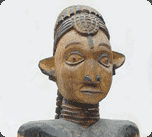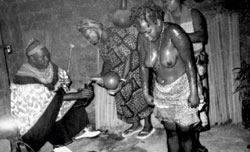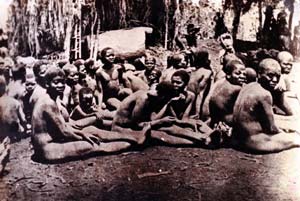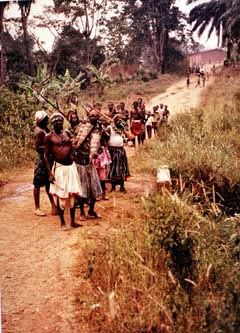
 |
|
| Mankon museum | |
| Permanent exhibition | |
| |
|
| |
|
| Informations | |
Art and Society
| In Mankon we are dealing with a society with a state (or fundamentally with a centralized chefferie/chieftaincy/fondom with a relatively strong political power for some), which is inegalitarian and hierarchical. The nuclear family includes a man, his wife (or wives), the unmarried children and even the married children with their wives. It occupies a hamlet grouped around the father’s house. The majority of households dominated by a polygamous man take on the aspect of an extended family, at times including three generations living together. |  |
|
| |
 |
Several families form lineages and clans with a view to permanent segmentation, of patrilineal filiation. Clan and lineage are designated by the same word atsey. In principle, a clan groups together all the people who are supposedly descended in agnatic filiation from a common ancestor. But the link of relationship in Mankon covers consanguinity, alliance by marriage and political alliance. In opposition to common lineages there are royal lineages. It is the heads of the lineages and the clans that represent the local groups in the central institutions, the arena of competition between clans. |
Lastly, social control, the resolution of conflicts and purification are ensured by the kwifo and mainly by ritual means using a rich material. The objects of the treasures of the king and the notables express stratification, hierarchy, cohesion and social values. Globally the public or secret display of the symbolic objects at dances and ceremonies by the fon, the notables and secret societies tend to have the beliefs, values, traditions and rules respected and to reinforce the prestige of the authorities and of the institutions. In addition, with the Mankon, ritual objects more than every other procedure, have in the first place a function of communication for social, religious, magic and political values also necessary for social cohesion. The way in which the Mankon express themselves by means of symbols and artistic forms make up a language of visual forms. |
 |
|
|
|
|
|
|
|
|
[ Top page ]
| Home | The four museums | The project | Baham museum | Bandjoun museum | Mankon museum | Babungo museum |
| mankon@museumcam.org | Copyright 2005 C.O.E. | Powered by Synus |





































